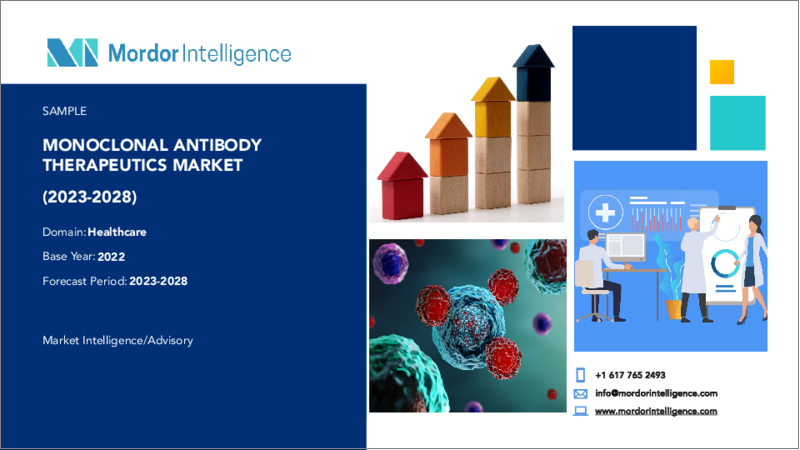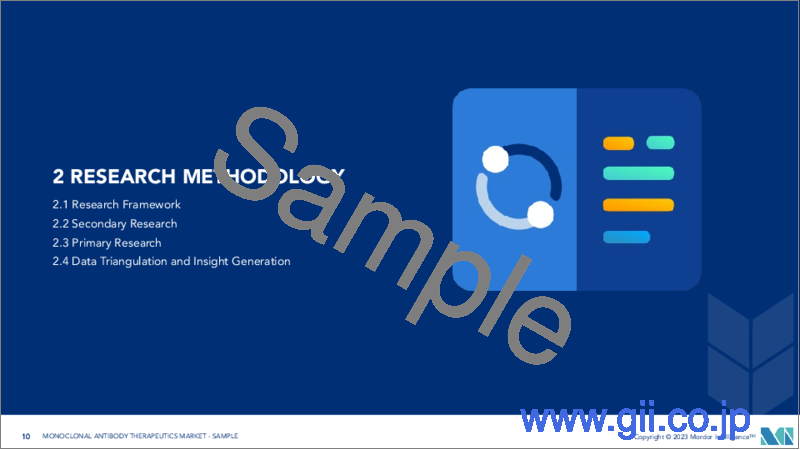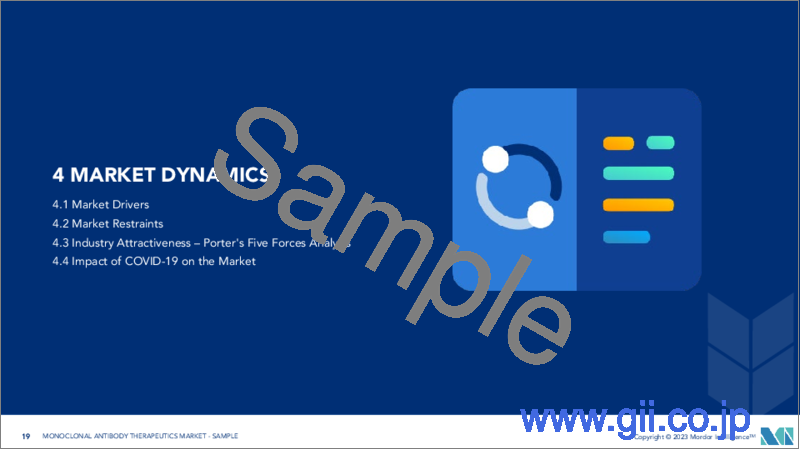|
|
市場調査レポート
商品コード
1273403
モノクローナル抗体治療薬市場- 成長、動向、予測(2023年-2028年)Monoclonal Antibody Therapeutics Market - Growth, Trends, and Forecasts (2023 - 2028) |
||||||
|
● お客様のご希望に応じて、既存データの加工や未掲載情報(例:国別セグメント)の追加などの対応が可能です。 詳細はお問い合わせください。 |
|||||||
| モノクローナル抗体治療薬市場- 成長、動向、予測(2023年-2028年) |
|
出版日: 2023年04月14日
発行: Mordor Intelligence
ページ情報: 英文 110 Pages
納期: 2~3営業日
|
- 全表示
- 概要
- 目次
モノクローナル抗体治療薬市場は、予測期間中に約13.2%のCAGRで成長すると予測されました。
COVID-19は、パンデミック時にウイルスを治療するためのモノクローナル抗体の利用が増加したなどの要因により、モノクローナル抗体治療薬市場に大きな影響を及ぼしました。例えば、2022年2月の更新によると、FDAは、オミクロン変異体に対する活性を保持するCOVID-19の治療のための新しいモノクローナル抗体の緊急使用承認(EUA)を発行しました。bebtelovimabの緊急使用承認(EUA)は、成人および小児患者における軽度から中等度のCOVID-19の治療が対象でした。さらに、2022年1月にJBS誌に掲載された論文にあるように、優れた特異性と信頼性を持つモノクローナル抗体(mAb)は、さまざまな疾患の診断や治療に有効な手段となっていました。多くの科学者が、SARS-CoV-2の検出のための抗体ベースのアッセイや、COVID-19治療薬として使用するAb医薬の開発に早速着手しました。このように、慢性疾患の有病率の増加やモノクローナル抗体治療薬の開発の活発化により、モノクローナル抗体治療薬市場は今後数年間で大きな影響を及ぼすと予想されています。
市場成長の主な要因は、関節リウマチ、炎症性腸疾患、クローン病、がんなどの自己免疫疾患の世界の有病率の上昇と、世界の負担を引き起こす老年人口の増加です。例えば、米国がん協会2022年最新版によると、2022年の新規がん患者数の推定値は190万人であることが判明しています。モノクローナル抗体は、体内の免疫機能を向上させ、がん細胞の増殖や転移を抑制する標的型抗がん剤として有望視されています。このため、がん患者の増加がモノクローナル抗体治療薬の増加につながり、予測期間中の市場成長を押し上げると予想されます。
また、近年、新製品が承認され、強力なパイプラインが構築されたことにより、モノクローナル抗体治療薬の市場規模が予測期間中に拡大することが期待されています。さらに、様々な疾患におけるモノクローナル抗体の大量購入の増加が、市場の成長を後押ししています。例えば、2022年2月の更新によると、米国保健福祉省(HHS)長官Xavier Becerraは、データがオミクロン変種に効くことを示した新しいモノクローナル抗体治療薬の60万治療コースの購入を報告しました。このようなモノクローナル抗体分野での取り組みが、市場の成長を後押しする大きな要因となっています。さらに、モノクローナル抗体の分野における研究開発と強力なパイプライン研究が、市場成長を押し上げています。例えば、2022年6月の更新によると、ジェネンテックは欧州血液学会年次総会2022で幅広い血液がんポートフォリオからポジティブなデータを発表しました。8年間の追跡調査の後、第III相GALLIUM試験の最終解析では、化学療法とともにガジーバ(オビヌツズマブ)を投与された未治療の濾胞性リンパ腫の患者は、引き続き無増悪生存期間にかなりの改善が見られることが明らかになりました。
したがって、自己免疫疾患の増加やモノクローナル抗体治療薬の製品上市の増加により、モノクローナル抗体市場は予測期間中に成長を示す可能性があります。しかし、心不全、肝障害、神経障害、乾癬、多くのアレルギー反応などの合併症のリスクが高いこと、市場開拓中の課題が多いこと、特許製品が高価であることが市場の成長を抑制しています。
モノクローナル抗体治療薬市場の動向
自己免疫疾患は、モノクローナル抗体治療薬市場で大きなシェアを占めると予想される
自己免疫疾患は、関節リウマチ、乾癬性関節炎、クローン病、ぶどう膜炎、若年性特発性関節炎などのさまざまな疾患の世界の流行により、市場の成長を示すと予測されています。例えば、2021年10月のCDCの更新によると、2040年までに18歳以上の米国成人の推定7,800万人(26%)が医師から診断された関節炎を有すると予測されています。
また、関節リウマチの治療薬として米国FDAに承認された完全ヒト型モノクローナル抗体「ヒュミラ」などの製品があることも、市場を後押ししています。2021年8月、FDAは特定の自己免疫疾患の治療にHADLIMAとして知られるヒュミラのバイオシミラー新バージョンの使用を承認しました。自己免疫疾患におけるモノクローナル抗体の進歩に基づく研究の増加は、市場の高揚成長要因となっています。例えば、2022年2月にTechnology Networksに掲載された記事のように、全身性エリテマトーデス(SLE)およびループス腎炎(LN)のモデルでCD6-ALCAM経路をブロックするために抗CD6モノクローナル抗体を使用すると、生存期間が延びる結果となりました。さらに、2022年8月のペン・メディシンのアップデートでは、リティフィリマブ(通称BIIB059)という実験薬が、皮膚に発症しQOLに深刻な影響を与える皮膚エリテマトーデス(CLE)に対する強力な長期治療となりそうです。このような臨床研究は、このセグメントの成長を促進し、予測期間における世界のモノクローナル抗体治療薬市場の収益を押し上げています。
したがって、自己免疫疾患の増加、自己免疫疾患に対するモノクローナル抗体治療薬の製品上市の増加により、モノクローナル抗体市場における自己免疫セグメントは予測期間中に成長する見通しです。
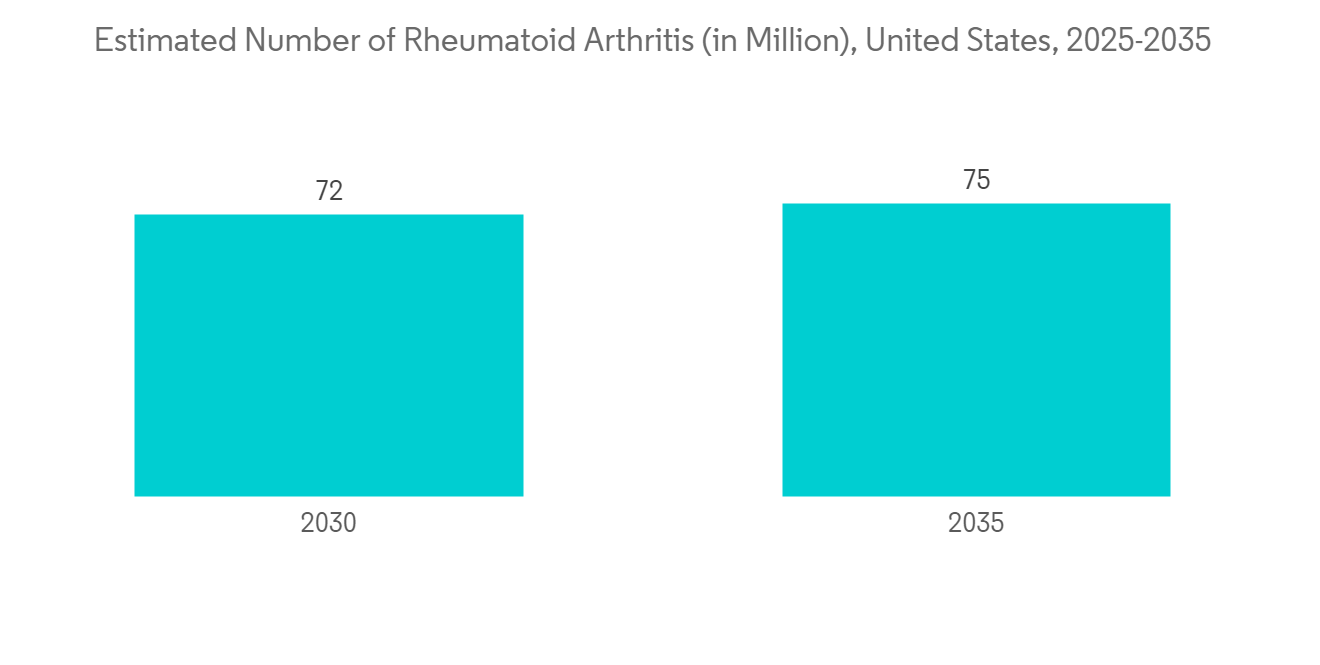
北米は予測期間中、モノクローナル抗体治療薬市場の成長を示すと予測される
北米は、自己免疫疾患の増加、医療費の増加、主要企業による巨額の投資、米国における多嚢胞性卵巣症候群(PCOS)や乳がんなどの様々な疾患の治療における治療薬の適用拡大に伴う研究開発活動の継続的な増加などの要因により、予測期間を通じてモノクローナル抗体医薬品市場全体において大きな割合を占めると予想されます。例えば、Breast Cancer.Orgによると、2022年には、米国の女性において浸潤性乳がんの新規症例が287,850件、非浸潤性(in situ)乳がんの新規症例が51,400件と推定されています。
さらに、モノクローナル抗体の領域に関連する競合他社の存在とその製品の発売は、市場成長の主な促進要因となっています。例えば、2022年8月のアップデートにより、アストラゼネカと第一三共のEnhertu(トラスツズマブ・デルクステカン)は、米国において、切除不能または転移性のHER2低値(IHC 1+またはIHC 2+/ISH-)乳がんで、転移設定での前化学療法を受けたか、補助化学療法中または完了後6カ月以内に疾患再発を起こした成人患者に対する治療を目的として承認されています。さらに、さまざまながん治療におけるモノクローナル抗体の研究開発に関連する共同研究は、市場の成長を後押しすると考えられます。例えば、2022年3月の最新情報によると、サノフィとブラックストーンは、多発性骨髄腫(MM)患者を治療するための抗CD38抗体Sarclisaの皮下製剤および送達に関する重要な国際試験および臨床開発プログラムを加速するために、最大で3億ユーロを提供すると考えられるBXLS(ブラックストーンライフサイエンス)が管理するファンドが戦略的リスク共有型提携に同意しました。成功した場合、BXLS社は、将来の皮下投与による売上に応じたロイヤルティを受け取ることができると予想されます。皮下注製剤のピボタル試験は、2022年後半に開始される予定です。
慢性疾患や自己免疫疾患の増加、モノクローナル抗体治療薬の製品上市の増加、モノクローナル抗体の市場開拓を含む戦略的パートナーシップにより、北米は予測期間中、モノクローナル抗体市場の成長を示すと予測されます。
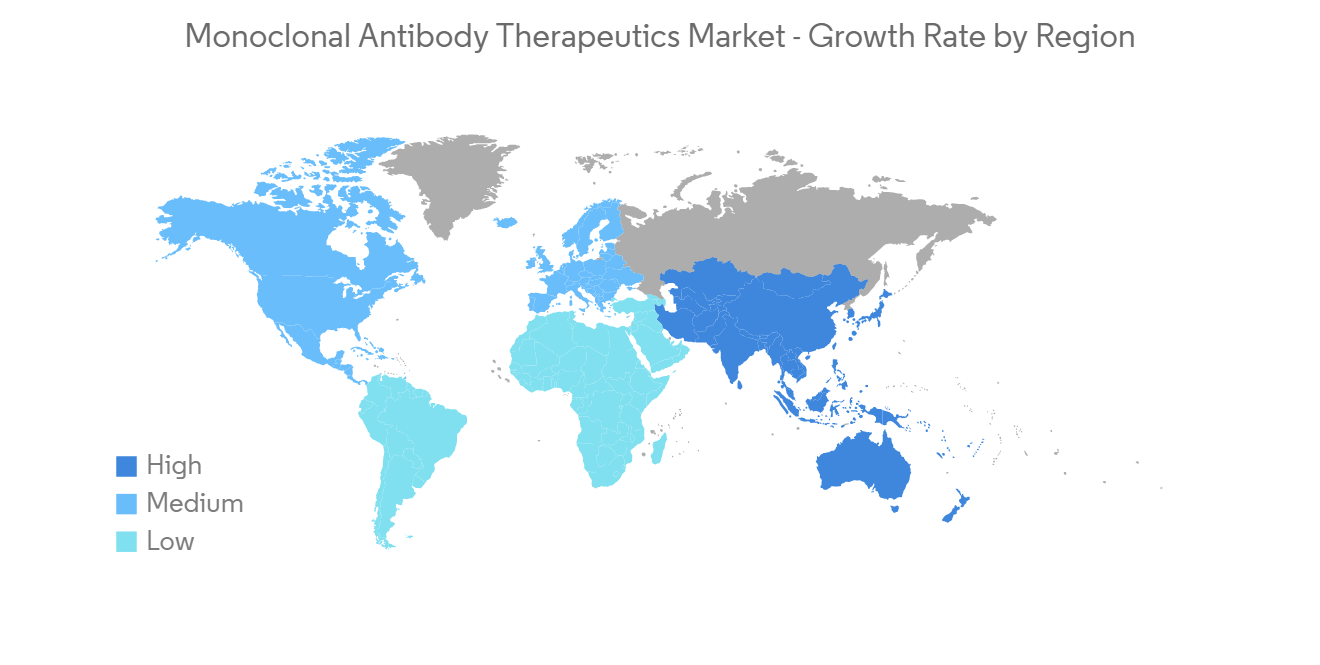
モノクローナル抗体治療薬産業の概要
モノクローナル抗体治療薬市場は、複数の大手企業によって構成されており、競争は緩やかです。市場シェアの面では、現在、数社の大手企業が市場を独占しています。一部の有力企業は、世界市場での地位を固めるために他社を買収しており、他の企業は新製品を発売しています。
その他の特典:
- エクセル形式の市場予測(ME)シート
- 3ヶ月間のアナリストサポート
目次
第1章 イントロダクション
- 調査の前提条件と市場定義
- 本調査の対象範囲
第2章 調査手法
第3章 エグゼクティブサマリー
第4章 市場力学
- 市場概要
- 市場促進要因
- 自己免疫疾患の世界の有病率の上昇と老年人口の増加
- USFDAによる早期医薬品承認イニシアティブに基づく新製品の上市
- 市場抑制要因
- 心不全、肝障害、神経障害、乾癬、多くのアレルギー反応などの合併症の高いリスク
- 開発段階での高い難易度と高価な特許製品
- ポーターファイブフォース
- 新規参入業者の脅威
- 買い手/消費者の交渉力
- 供給企業の交渉力
- 代替品の脅威
- 競争企業間の敵対関係
第5章 市場セグメンテーション(市場規模、金額)
- アプリケーション別
- 血液疾患
- 自己免疫疾患
- がん
- その他
- 供給元別
- ヒト
- ヒト化
- キメラ
- その他
- エンドユーザー別
- 病院
- 民間診療所
- その他
- 地域別
- 北米
- 米国
- カナダ
- メキシコ
- 欧州
- ドイツ
- 英国
- フランス
- イタリア
- スペイン
- その他欧州
- アジア太平洋地域
- 中国
- 日本
- インド
- オーストラリア
- 韓国
- その他アジア太平洋地域
- 中東・アフリカ地域
- GCC
- 南アフリカ
- その他中東とアフリカ
- 南米
- ブラジル
- アルゼンチン
- その他南米地域
- 北米
第6章 競合情勢
- 企業プロファイル
- UCB S.A., Belgium(UCB Inc)
- Pfizer Inc
- Amgen Inc
- AbbVie Inc
- Johnson & Johnson
- F. Hoffmann-La Roche Ltd
- Boehringer Ingelheim International GmbH
- Novartis AG
- Merck KGaA
- Daiichi Sankyo Company Limited
第7章 市場機会および将来動向
The monoclonal antibody therapeutics market studied was anticipated to grow with a CAGR of nearly 13.2% during the forecast period.
COVID-19 had a significant impact on the monoclonal antibody therapeutics market owing to the factors such as increased utilization of monoclonal antibodies to treat the virus during the pandemic. For instance, as per the February 2022 update, the FDA issued an emergency use authorization (EUA) for a new monoclonal antibody for the treatment of COVID-19 that retains activity against the omicron variant. The emergency use authorization (EUA) for bebtelovimab was for the treatment of mild to moderate COVID-19 in adults and pediatric patients. Furthermore, as per the article published in January 2022 in JBS journal, monoclonal antibodies (mAbs), which had great specificity and dependability, had become effective instruments for diagnosing and treating a wide range of disorders. Many scientists have started working immediately on developing antibody-based assays for the detection of SARS-CoV-2 and Ab medications for use as COVID-19 treatment agents. Thus, the monoclonal antibody therapeutics market is anticipated to have a significant impact in the coming years due to the increase in the prevalence of chronic disease and the rise in the development of monoclonal antibody therapeutics.
The major factors attributing to the growth of the market are a rise in the global prevalence of autoimmune disorders such as rheumatoid arthritis, inflammatory bowel disorder, Crohn's disease, and cancers, and an increased geriatric population causing a global burden. For instance, as per the American Cancer Society 2022 update, the estimated number of new cancer cases in 2022 is found to be 1.9 million. Monoclonal antibodies are a promising class of targeted anticancer agents that improve the functions of the body's immune system to inhibit the growth and spread of cancer cells. Thus increase in cancer cases is anticipated to increase the monoclonal antibody therapeutics, thereby boosting the market growth over the forecast period.
A few more factors play a pivotal role in taking the market to the next level, such as the approval of new products in recent years and a strong pipeline expected to fuel the monoclonal antibody therapeutics across the forecast period. Moreover, the increased purchase of monoclonal antibodies in various diseases in bulk is fuelling market growth. For instance, as per the February 2022 update, United States Department of Health and Human Services (HHS) Secretary Xavier Becerra reported a purchase of 600,000 treatment courses of a new monoclonal antibody treatment that data showed works against the Omicron variant. Such initiatives in the field of monoclonal antibodies are major factors fuelling the market growth. Moreover, the research and development and strong pipeline studies in the field of monoclonal antibodies are uplifting the market growth. For instance, as per the June 2022 update, Genentech presented positive data from a broad blood cancer portfolio at European Hematology Association Annual Meeting 2022. After eight years of follow-up, the Phase III GALLIUM study's final analysis revealed that patients with previously untreated follicular lymphoma who received Gazyva (obinutuzumab) with chemotherapy continued to see a considerable improvement in progression-free survival.
Hence, due to the rise in autoimmune disease, and the increase in product launches in monoclonal antibody therapeutics, the monoclonal antibody market is likely to witness growth over the forecast period. However, the high risk of complications such as heart failure, liver injury, neurological disorders, psoriasis, and many allergic reactions, high challenges while in the development stage, and expensive patented products restrain the market growth.
Monoclonal Antibody Therapeutics Market Trends
Autoimmune Diseases are Expected to Hold the Significant Market Share in the Monoclonal Antibody Therapeutics Market
Autoimmune diseases are anticipated to witness growth in the market due to the global prevalence of various diseases such as rheumatoid arthritis, psoriatic arthritis, Crohn's disease, uveitis, and juvenile idiopathic arthritis. For instance, as per the October 2021 CDC update, by 2040, an estimated 78 million (26%) United States adults aged 18 years or older are projected to have doctor-diagnosed arthritis.
Also, the availability of products such as Humira, a fully human monoclonal antibody approved by the US FDA for the treatment of rheumatoid arthritis fueling the market. In August 2021, FDA approved the use of a new version of a HUMIRA biosimilar known as HADLIMA to treat certain autoimmune disorders. The increased research based on the advancement of monoclonal antibodies in autoimmune disease is an uplifting growth factor in the market. For instance, as per the article published in February 2022 in Technology Networks, using an anti-CD6 monoclonal antibody to block the CD6-ALCAM pathway in models of systemic lupus erythematosus (SLE) and lupus nephritis (LN) resulted in prolonged survival. Furthermore, as per the August 2022 update from Penn Medicine, an experimental drug called litifilimab (known as BIIB059) is likely to be a powerful long-term treatment for cutaneous lupus erythematosus (CLE), a form of lupus that occurs in the skin and can severely impact the quality of life. This kind of clinical study is fuelling the growth of the segment and propelling the global monoclonal antibody therapeutics market revenue in the forecast period.
Hence, due to the rise in autoimmune disease, and the increase in product launches in monoclonal antibody therapeutics for autoimmune disease, the autoimmune segment in the monoclonal antibody market is likely to witness growth over the forecast period.

North America is Anticipated to Witness a Growth in the Monoclonal Antibody Therapeutics Market Over the Forecast Period
North America is expected to hold a significant share in the overall monoclonal antibody therapeutics market throughout the forecast period owing to the factors such as a rise in autoimmune diseases, increased healthcare expenditure, huge investments by the key players, and continuous growth in R&D activities with the rise in application of these therapeutics in the treatment of various disorders such as (PCOS) polycystic ovary syndrome, breast cancers in the United States. For instance, as per Breast Cancer.Org, in 2022, an estimated 287,850 new cases of invasive breast cancer are expected to be diagnosed in women in the United States., along with 51,400 new cases of non-invasive (in situ) breast cancer.
Furthermore, the presence of competitors and their product launches relating to the area of monoclonal antibodies are a major fuelling factor for the market growth. For instance, as per the August 2022 update, AstraZeneca and Daiichi Sankyo's Enhertu (trastuzumab deruxtecan) was approved in the United States for the treatment of adult patients with unresectable or metastatic HER2-low (IHC 1+ or IHC 2+/ISH-) breast cancer who have received prior chemotherapy in the metastatic setting or developed disease recurrence during or within six months of completing adjuvant chemotherapy. Moreover, collaborations relating to the research and development of monoclonal antibodies in different cancer treatment is likely to boost the market growth. For instance, as per the March 2022 update, Sanofi and Blackstone agreed to a strategic, risk-sharing collaboration under which funds managed by Blackstone Life Sciences (BXLS) that is likely to contribute up to EUR 300 million to accelerate the pivotal global studies and the clinical development program for the subcutaneous formulation and delivery of the anti-CD38 antibody Sarclisa, to treat patients with multiple myeloma (MM). If successful, BXLS is anticipated to be eligible to receive royalties on future subcutaneous sales. The pivotal study for the subcutaneous formulation is expected to begin in the second half of 2022.
Hence, due to the rise in chronic diseases and autoimmune diseases, and the increase in product launches in monoclonal antibody therapeutics, strategic partnerships involving the expansion of monoclonal antibody development, North America is anticipated to witness growth in the monoclonal antibody market over the forecast period.

Monoclonal Antibody Therapeutics Industry Overview
The monoclonal antibody therapeutics market is moderately competitive and consists of several major players. In terms of market share, a few of the major players are currently dominating the market. Some prominent players are acquiring other companies to consolidate their market positions across the globe and while others are launching new products. Some of the companies which are currently dominating the market are Abbvie Inc, Daiichi Sankyo Company Limited, Johnson & Johnson, Amgen Inc, and UCB S.A., Belgium (UCB Inc).
Additional Benefits:
- The market estimate (ME) sheet in Excel format
- 3 months of analyst support
TABLE OF CONTENTS
1 INTRODUCTION
- 1.1 Study Assumptions and Market Definition
- 1.2 Scope of the Study
2 RESEARCH METHODOLOGY
3 EXECUTIVE SUMMARY
4 MARKET DYNAMICS
- 4.1 Market Overview
- 4.2 Market Drivers
- 4.2.1 Increasing Global Prevalence of Autoimmune Disorders and Rise in Geriatric Population
- 4.2.2 New Product Launches with Accelerated Drug Approval Initiative by USFDA
- 4.3 Market Restraints
- 4.3.1 High Risk of Complications such as Heart Failure, Liver Injury, Neurological Disorders, Psoriasis and many Allergic Reactions
- 4.3.2 High Challenges while in the Development Stage and Expensive Patented Products
- 4.4 Porter Five Forces
- 4.4.1 Threat of New Entrants
- 4.4.2 Bargaining Power of Buyers/Consumers
- 4.4.3 Bargaining Power of Suppliers
- 4.4.4 Threat of Substitute Products
- 4.4.5 Intensity of Competitive Rivalry
5 MARKET SEGMENTATION (Market Size by Value - USD Million)
- 5.1 By Application
- 5.1.1 Hematological Diseases
- 5.1.2 Autoimmune Diseases
- 5.1.3 Cancer
- 5.1.4 Others
- 5.2 By Source
- 5.2.1 Human
- 5.2.2 Humanized
- 5.2.3 Chimeric
- 5.2.4 Others
- 5.3 By End-user
- 5.3.1 Hospitals
- 5.3.2 Private Clinics
- 5.3.3 Others
- 5.4 Geography
- 5.4.1 North America
- 5.4.1.1 United States
- 5.4.1.2 Canada
- 5.4.1.3 Mexico
- 5.4.2 Europe
- 5.4.2.1 Germany
- 5.4.2.2 United Kingdom
- 5.4.2.3 France
- 5.4.2.4 Italy
- 5.4.2.5 Spain
- 5.4.2.6 Rest of Europe
- 5.4.3 Asia-Pacific
- 5.4.3.1 China
- 5.4.3.2 Japan
- 5.4.3.3 India
- 5.4.3.4 Australia
- 5.4.3.5 South Korea
- 5.4.3.6 Rest of Asia-Pacific
- 5.4.4 Middle East and Africa
- 5.4.4.1 GCC
- 5.4.4.2 South Africa
- 5.4.4.3 Rest of Middle East and Africa
- 5.4.5 South America
- 5.4.5.1 Brazil
- 5.4.5.2 Argentina
- 5.4.5.3 Rest of South America
- 5.4.1 North America
6 COMPETITIVE LANDSCAPE
- 6.1 Company Profiles
- 6.1.1 UCB S.A., Belgium (UCB Inc)
- 6.1.2 Pfizer Inc
- 6.1.3 Amgen Inc
- 6.1.4 AbbVie Inc
- 6.1.5 Johnson & Johnson
- 6.1.6 F. Hoffmann-La Roche Ltd
- 6.1.7 Boehringer Ingelheim International GmbH
- 6.1.8 Novartis AG
- 6.1.9 Merck KGaA
- 6.1.10 Daiichi Sankyo Company Limited
